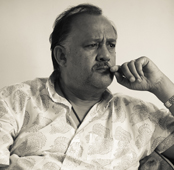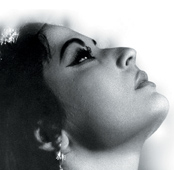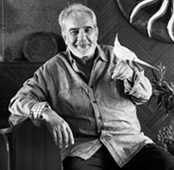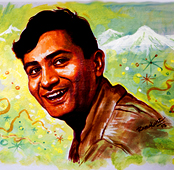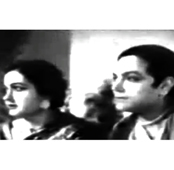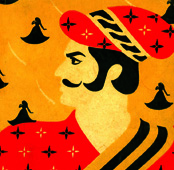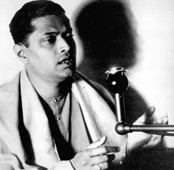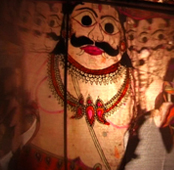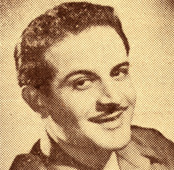-
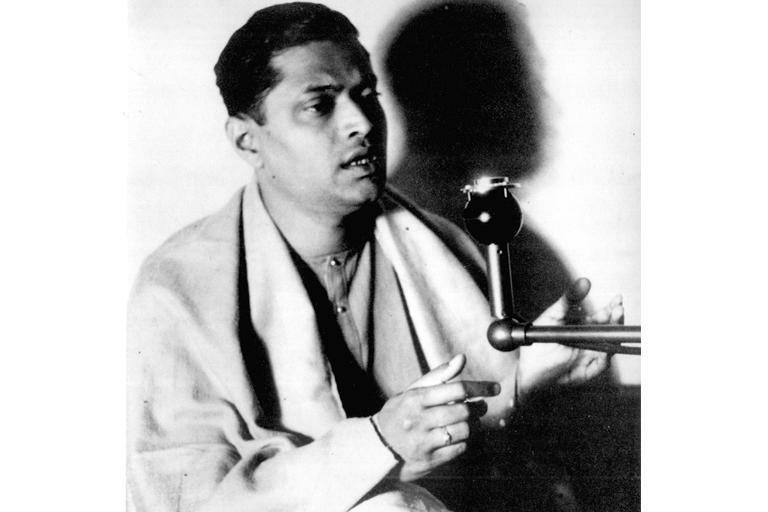 Pankaj Mullick singing live on AIR (c) Rajib Gupta
Pankaj Mullick singing live on AIR (c) Rajib Gupta
The past is not a foreign country but it is certainly largely undiscovered. In TBIP’s History Corner we bring to you stories, characters and anecdotes from times that must not be allowed to go away merely because they have gone by.
He was so passionate about music that he would break into song and sing along to the rhythm of a water pump, or the hum of his car’s engine. Such are the stories that Rajib Gupta has heard about his grandfather Pankaj Mullick. A legend and pioneer in Indian film music, Pankaj Mullick’s (1905-1978) legacy ranges from bringing playback singing to Indian cinema and introducing Rabindra Sangeet (songs written and mostly composed by Rabindranath Tagore) in films, to creating AIR (All India Radio) radio programmes that are still talked of.
Mullick was born and brought up in a middle class family in Calcutta. His father Manimohan Mullick was a Bada Babu (officer) with the British Administration. His mother Monomohini Mullick was a housewife. He showed an inclination towards music from a very young age, picking up songs and singing from the age of three. When he was ten, he started his formal training in music under Durgadas Bandyopadhyay. He went on to learn Rabindra Sangeet under Dinendranath Tagore, Rabindranath Tagore’s grandnephew.
Mullick’s tryst with composing music began with the All India Radio in 1927, when it was still a British company known as the Indian Broadcasting Company. His composition of the radio programme Mahishasuramardini is among his most famous works. It first aired in 1931 and continues to play on AIR even today. “It has actually become a part of Bengali culture. It is still broadcast today,” says Gupta. The programme plays at daybreak, every Mahalaya, marking the beginning of Durga Puja.
His ‘music class’ on radio, named Sangeet Shikshar Ashar, a programme that was on air for almost 47 years, introduced and popularized Rabindra Sangeet among its audience.
***
In his first few years as a composer, Mullick collaborated with his colleague Rai Chand Boral in radio and in cinema. Their work on radio caught the attention of New Theatres, one of the biggest Indian film producers of the time. New Theatres invited Mullick and Boral to run their music department and they agreed. This was their first step into the world of Indian cinema.
They started with composing music for two Bengali silent films—Chasher Meye and Chor Kanta—in 1931. They also conducted the live orchestras for the shows of these films. The same year, they composed music for their first talkie, Premankur Atorthy’s Dena Paona (also a Bengali movie).
Mullick and Boral worked together on around 20 films. Their first commercial hit was Nitin Bose’s Chandidas (Bengali, 1934). The trio of Bose, Mullick and Boral would go on to create history in Indian cinema. Through interviews with his grandfather’s contemporaries, Gupta has pieced together how an ‘accident’ changed Indian film music forever. “The director of the movie (Bose) had come to pick him (Mullick) up to go to the studio together. There was an English song playing next door and the director thought that my grandfather was singing it. When he came out, he asked: ‘Were you singing that?’ My grandfather said, ‘No.’ But the voice sounded very similar to my grandfather’s. So he (Bose) said, ‘You do something. Start singing the words without putting your voice in.’” This was the seed of the idea that would introduce playback singing to Indian films. At their studio, Mullick and Boral refined this experiment and playback singing was used for the first time in Indian cinema in Bose’s Bengali Bhagya Chakra (1935), as well as in its Hindi remake Dhoop Chhaon, which released in the same year.
Teri Gathri Mein Laga Chor from Dhoop Chhaon:
It was with the film Mukti (Bengali, 1937) that Mullick went solo as music director. The film’s music broke new ground, using Rabindra Sangeet in film music for the first time. At the film’s narration, director Prathamesh Chandra Barua heard Mullick hum a song and insisted on using it in the film. Says Gupta: “He (Mullick) said ‘These are words by (Rabindranath) Tagore, but the music is mine.’” At a time when Rabindra Sangeet was actually restricted to a closed, elite circle, Barua insisted on using the song in his film. “Till then nobody had ever sung Tagore’s songs, in public, to their own tune. It was not allowed,” Gupta says. “It was very seriously protected by the Tagore family.”
For permission to use Rabindra Sangeet, Mullick met Rabindranath Tagore. According to Gupta, Tagore was so overwhelmed after listening to the song that along with granting permission for its use in the film, he also suggested a few others. Tagore set tune to as many of his poems and lyrics as he could during his lifetime, but gave Mullick the honour of setting tune to the rest of them after his death.
Pankaj Mullick sings Diner Sheshe in Mukti:
***
Mullick usually sang for the songs he composed himself. When he worked with other singers, they were well-known names like Kundan Lal Saigal, Pahari Sanyal, Kanan Devi and Uma Shashi. His experiments with music extended to pushing the boundaries of classical music. Calling him the forefather of popular music today, Gupta says: “There were definite elements of classical music (in his songs) because they were grammatically quite correct with ragas and raginis. Yet, while he derived from it, he didn’t stick to the classical genre.” Mullick began using western instruments like the English flute, violin and double bass. “He wanted to make the sound different without moving too away from the melodic character of Indian songs. He did not take the western sound structure. He stuck to the Indian sound structure.” In the song Duniya Rang Rangili from Dharti Mata (1938) Mullick incorporated Western musical elements like harmonization and counter-melody.
For film music historian Pavan Jha, Mullick was a visionary. Pointing to his work in non-film music, he says: “A favourite of mine is Yeh Raatein, Yeh Mausam, Yeh Hasna Hasaana, a song written by Fayyaz Hashmi. The way he has used the orchestra, and the composition for it, it was very ahead of its time.” He adds: “People say it was O. P. (Omkar Prasad) Nayyar, but it was Pankaj Mullick who first brought in the famous ‘horse-cart rhythm’ (a rhythm created out of the sound made by a horse-cart in motion), to Hindi film music.”
Pankaj Mullick’s Chale Pawan Ki Chaal from Doctor (1941):
O. P. Nayyar’s Piya Piya Piya Mera Jiya Pukaare from Baap Re Baap (1955):
https://www.youtube.com/watch?v=6c1H59dL62E
Pankaj Mullick’s contribution to Indian cinema was not confined to music. He was also an actor, playing lead roles in films such as Mukti and Doctor. However, music remained his first love. He composed and sang classics such as Piya Milan Ko Jaana from Kapalkundala (1939), Yeh Kaun Aaj Aaya Savere Savere from Nartaki (1940), Aayi Bahar and Chale Pawan Ki Chaal from Doctor (1941), as well as songs from his private albums- Tere Mandir Ka Hoon Deepak, Pran Chahe Nain Na Chahe and Yaad Aayi Ki Na Aaye.
His other famous compositions include Tu Dhoondhta Hai Jisko from Yatrik (1952) sung by Dhananjay Bhattacharya, Main Kya Janu Kya Jadu Hai from Zindagi (1940), Karun Kya Aas Niraas Bhai from Dushman (1939) and Do Naina Matware from Meri Bahen (1944), sung by K. L. Saigal.
Mullick became one of the country’s most respected and sought after music directors. But, unlike his contemporaries who moved to Bombay as the Hindi film industry set its roots there, Mullick continued to work from Calcutta throughout his life.
Play It Back
SpecialJuly 2013
 By Meryl Mary Sebastian
By Meryl Mary Sebastian
Meryl Mary Sebastian is Junior Correspondent at The Big Indian Picture



